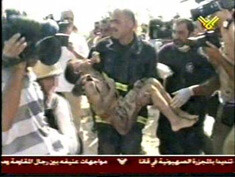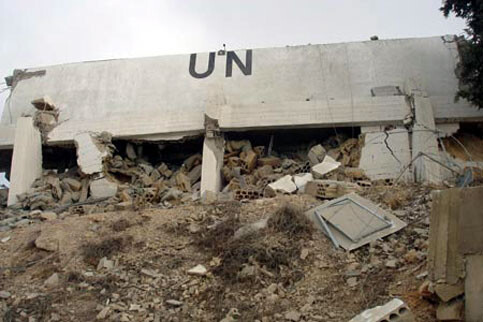Lebanon 3 November 2006

UNIFIL forces monitor the Israel-Lebanon border (UN Photo)
On the 15th of March, 1978 the Lebanese government submitted a complaint to the Security Council against the Israeli invasion and occupation of the entire southern part of the country except for the city of Tyre and its surrounding area. As a result, the Security Council adopted resolution 425 and 426 in which it called upon Israel to immediately cease its military action and withdraw its forces from all Lebanese territory, and decided on the immediate establishment of the United Nations Interim Force in Lebanon (UNIFIL) whose troops arrived in the area on the 23rd of March 1978.
According to the Security Council, the interim force was created for three purposes: confirming the withdrawal of Israeli forces, restoring international peace and security, and assisting the government of Lebanon in ensuring the return of its effective authority in the area. UNIFIL claims success of the implementation of two of the objectives: confirming the withdrawal of Israel — which is not true since Israel holds military presence in the Lebanese Shebaa Farms and recently in the Al Gajar village; and assisting the Lebanese government in regaining control in the area — a role whose credibility and effectiveness are very ambiguous.
Before Security Council resolution 1701 in 2006 that raised UNIFIL presence in Lebanon to 15,000 troops, UNIFIL operated with a force consisting of some 1,990 troops assisted by 50 military observers from the UN Truce Supervision Operation (UNTSO) based in Jerusalem and supported by 95 international civilian personnel and 295 local civilian staff. The force till that date included participation from France, China, Ghana, India, Ireland, Italy and Poland; and operated with an annual budget of $94.2 million.
The UNIFIL presence in southern Lebanon proved useless in protecting the civilian population from the continuous Israeli attacks. This was obvious especially with the bombing of a UN compound in Qana in 1996 and the UN silence in reaction to this crime. The compound was a concentration point for refugees who fled the heavy Israeli bombing of their villages. Around 800 civilians were present in the UN compound on the 18th of April, 1996 - the day of the shelling that resulted in 106 civilian deaths and 120 seriously injured, including four Fijian UNIFIL soldiers.

Ten years after the first massacre, Qana civilians were once again unprotected from Israeli attacks in 2006 (Al-Jazeera screenshot)

Over 100 civilians were killed in Qana in 1996, while 26 were killed in an air strike this summer (Al-Jazeera screenshot)
Israel claimed that it was responding to Katyusha firing from Hezbollah fighters from that area and that the presence of the civilian population was unknown to them. However, Lieutenant General Amnon Shahak, Israel’s chief of staff at the time, stated, “I don’t see any mistake in judgment … We fought Hezbollah there, and when they fire on us, we will fire on them to defend ourselves … I don’t know any other rules of the game, either for the army or for civilians …”. The investigation conducted by the UN-appointed military advisor Major General Franklin van Kappen of the Netherlands found that “during the shelling there was a perceptible shift in the weight of fire from the mortar site to the United Nations compound.” It was found out during the investigation that “contrary to repeated denials, two Israeli helicopters and a remotely piloted vehicle were present in the Qana area at the time of the shelling,” concluding that “while the possibility cannot be ruled out completely, it is unlikely that the shelling of the United Nations compound was the result of gross technical and/or procedural errors.”
Amnesty International concluded after an on-site investigation in collaboration with military experts and interviews with UNIFIL staff and civilians in the compound that “the IDF (Israeli Defense Forces) intentionally attacked the UN compound, although the motives for doing so remain unclear. The IDF have failed to substantiate their claim that the attack was a mistake. Even if they were to do so they would still bear responsibility for killing so many civilians by taking the risk to launch an attack so close to the UN compound.”
Despite all the investigations and the incriminating evidences against Israel, the state was not held accountable beyond diplomatic condemnation. It is worth mentioning that Qana was once again targeted by Israeli army, amongst other villages, during this year’s Israeli war on Lebanon when Isaeli air strikes tumbled down a three-story residential building sheltering refugees fleeing the Israeli war machine from nearby villages, resulting in 28 civilian deaths, out of which 16 were children. According to the statement of the International Red Cross, the continuous Israeli bombing of the road to Qana hindered the rescue work, while Human Rights Watch reported that “… none of the dozens of international journalists, rescue workers and international observers who visited Qana on the 30th and 31st reported seeing any evidence of Hezbollah military presence in or around the home. Rescue workers recovered no bodies of apparent Hezbollah fighters from inside or near the building.” This Israeli massacre, as the rest, received almost no accountability beyond diplomatic scolding. On the contrary, the discourse of the United Nations, in the person of its Secretary-General Kofi Annan, stressed on the disarming of Hezbollah with a shy condemnation to Israel.
During the 28-year presence of the UNIFIL in the south of Lebanon, Israel did not once respond to any UN demands in holding back its war machine, nor in responsding to Security Council resolution 425 — and still no measures were taken against the state. During this summer’s Israeli war on Lebanon, UN posts and personnel were repeatedly targeted by the Israeli army, resulting in the four deaths of UN military personnel from Finland, China, Austria and Canada, two deaths within the UN civilian personnel from India, and 12 wounded.
In a briefing on 26th of July, 2006, Ms. Jane Holl Lute, assistant secretary general for the peacekeeping operations stated that “… events unfolded as follows … Patrol Base Khiyam, a long-established and clearly-marked UN position in the eastern section of UNIFIL’s area of operation … came under recurrent incidents of close firing.” The briefing explained, “UNIFIL reported that, in total 21 strikes occurred within 300 meters of the Patrol Base and 12 artillery rounds fell within 100 meters of the Base, four of which hit the Base directly. To our knowledge, unlike in the vicinity of our other Patrol Bases, Hezbollah firing was not taking place within the immediate vicinity of the Patrol Base.” According to the report, UNIFIL protested directly to the Israeli army each of these incidents of firing close to the base, and that the Deputy Secretary-General and Ms. Lute made several calls to the Permanent Mission of Israel to the United Nations reiterating these protests and calling for an abatement of the shelling.

The attacked UNIFIL post in Khiam where four peacekeepers were killed (UN Photo)
The UNIFIL confirms two final firings close to the base before communication with the position was lost. As a result of the direct attack the four UN military observers were killed. Other incidents of firing close to the UNIFIL positions were mentioned in Ms. Lute’s briefing and in the accounts of UNIFIL personnel present in the area. UNIFIL has reported, according to Ms. Lute, 145 incidents of “firing close,” of which 16 were direct hits on its positions. Several positions sustained more than one direct hit, causing various degrees of damage to buildings, equipment and vehicles. UNIFIL also reported that Israeli artillery rounds impacted approximately 10 meters from its headquarters compound in Naqoura. Neither UNIFIL nor the UN took any measure to hold Israel accountable to any of these incidents, nor to the almost total destruction of tens of Lebanese villages and heavy targeting of hundreds of civilian areas through out the country — and of course not to its direct responsibility for the 1,191 civilian deaths, 4,407 civilian injuries, a million displaced, around 10,000 tons of fuel oil spilled in the Mediterranean, severe damage to the infrastructure and a left-over of hundreds of thousands of unexploded cluster bombs scattered in residential areas and agricultural fields.
Despite of all wthis, resolution 1701 instated a zone extending between the previously set Blue Line and the Litani river in Lebanon that was free of “any armed personnel”, meaning the Israeli army and Hezbollah, since both the Lebanese Army and the UNIFIL forces are armed and present in this zone. Though Israel is responsible for atrocities against humanity and the environment, the United Nations failed to put any restrictions nor blame on it. The establishment of the zone free from any armed personnel on the Lebanese side poses a clear biased stand in support of the demands of the Israeli war machine in putting the full blame on the Lebanese resistance, represented by Hezbollah. This did not take into account international and local voices calling for the halt of Israeli aggression against Lebanon that have continued since 1978, nor the numerous international and local human and environmental rights organizations and activists’ calls to held Israel accountable for numerous crimes against humanity and for intentional ecological devastation. Resolution 1701 ignores, apparently deliberately, the investigations held not only by the United Nations itself, but also independent investigations conducted by international organizations like Human Rights Watch, Greenpeace, and Amnesty International — only to name a few — which find Israel responsible for serious violations on many levels, some irreversible. Resolution 1701 equates between an act of invasion and aggravated damage to the Lebanese infrastructure, environment, and population both Lebanese and Palestinian, with the legitimate response and (in comparison to Israel’s military power) the microscopic military power of Hezbollah.
All this raises a big question mark on the UNIFIL presence in Lebanon and their hidden agenda. It is clear that they are not here to halt Israel, and without a halt to Israeli terrorism there is no solution in the region. So what are they here for?
Imad Mortada is a Lebanese anarchist queer activist and Indymedia volunteer based in Barcelona. His writings can currently be read on qursana.blogspot.com
Related Links


